Crowded Smiles: How to Fix a Bite with Too Many Teeth
Misaligned bites are much more than an aesthetic issue: they can become a source of lifelong dental problems for your child. To prevent that, if your kid has a crossbite, overbite, underbite, or any type of misalignment, your orthodontist on Fordham Road will suggest early orthodontic intervention.
Crowded bites are one common type of malocclusion often seen in children and young adults. When the upper and lower mandibles develop, some patients simply lack enough space to accommodate all of their teeth. In this article, we'll explore treatment options for this condition, so you can help your child regain that beautiful, straight, shining smile.

What's a Bite with Crowded Teeth?
When there are too many teeth on the bite for proper alignment, it is known as a "crowded bite." When you have malocclusion, your upper and lower teeth don't fit together properly when you close your mouth.
Several things, including diet, dental trauma, and habits like tooth sucking, can cause malocclusion. However, genetic conditions are often the cause of crowded bites. If your siblings, grandparents, or biological parents also have misaligned teeth, your child is more likely to have them as well. However, it can also be brought on by other factors, such as the early loss of primary teeth.
When teeth must compete for space in the upper and/or lower jaw, dental crowding occurs. They become misaligned, twisted, or even begin to invert toward the back of the mouth as a result. This throws off your bite.
Unfortunately, in addition to being painful, crowded bites can lead to a number of long-term dental issues.
Is Dental Crowding Bad for Your Child’s Teeth?
Dental crowding has both immediate and long-term negative effects on your oral health. Some issues that may result from an untreated crowded bite include:
- Temporomandibular joint dysfunction (TMD)
- Gum/periodontal disease
- Cavities
- Aching jaw or teeth
- Difficulties chewing
Furthermore, people who have misaligned teeth frequently experience self-consciousness when they smile. According to the American Association of Orthodontists, getting overcrowded bites treated around age seven can help avoid all of these problems.

Can You Fix a Crowded Bite with Braces?
Yes, you can fix a crowded bite with braces. Braces are one of the most effective and commonly used orthodontic treatments for correcting dental crowding in both children and adults. That's because braces can widen the dental arch to create more room, especially for children who receive early treatment.
Braces use brackets, wires, and bands to gradually shift teeth into better alignment over time. This gentle, continuous pressure, in combination with elastics or springs to guide the teeth more precisely, allows orthodontists to create space and rearrange your bite into a healthier position.
After the braces are removed, retainers maintain the new alignment and prevent relapse.
Can You Fix a Crowded Bite with Invisalign?
Depending on the severity of the crowding and the patient's overall dental health, some cases of overcrowding can be fixed with clear aligners. These orthodontic appliances have become a more comfortable and discreet alternative to traditional braces for correcting mild to moderate dental crowding.
Invisalign uses a series of custom-made, clear plastic aligners that gradually shift your teeth into alignment. Each set of aligners is worn for about two weeks before switching to the next set, with treatment typically lasting 12 to 18 months, though this varies.
Each aligner tray applies gentle, targeted pressure to specific teeth. Over time, they create space in an overcrowded jaw, while guiding teeth into better alignment. In more severe cases, interproximal reduction (IPR) may create tiny spaces between crowded teeth by gently polishing the sides.
When Invisalign Might Not Be Enough
While Invisalign® is effective for most cases of mild to moderate crowding, severe crowding, especially when associated with skeletal jaw issues, might still require:
- Palatal Expanders
A palatal expander is an orthodontic device used to widen the upper jaw (palate) to correct crossbites, create room for crowded teeth, and improve overall bite alignment. It gradually applies gentle pressure to the molars, encouraging bone growth in the mid-palatal suture.
This expansion creates more space in the mouth, which can help align teeth without extractions. It’s especially effective in children and teens.
- Tooth Extractions
Tooth extraction involves removing one or more teeth, often recommended when overcrowding prevents proper alignment with orthodontic treatment. It is commonly used to create space for remaining teeth to shift into a healthier, straighter position.
While not always necessary, extractions may be essential in moderate to severe crowding cases or when a tooth is impacted or non-restorable.
- Orthognathic Surgery (in Extreme Cases)
Orthognathic surgery, or corrective jaw surgery, is performed to reposition the jaws when skeletal discrepancies cannot be corrected with orthodontics alone. It is typically used in severe bite misalignments, such as underbites or open bites, especially when accompanied by facial imbalance or breathing issues.
The surgery is done by an oral and maxillofacial surgeon and often combined with braces before and after to ensure optimal bite function and facial symmetry.
Are Dental Extractions Needed Before Braces?
Sometimes, when there is sufficient room in the mouth for all of the teeth to straighten properly, or if the teeth can't be straightened properly, an orthodontist will advise you to get a dental extraction. Approximately 25% of orthodontic brace cases necessitate dental extractions from impacted front teeth.
A tooth extraction may be your best bet if your teeth are crowded or if the extracted tooth is impacted or irreparable. Impaction is a condition where a tooth erupts at an angle instead of straight up and down, making it more challenging to treat with braces.
It is usually best to heed your orthodontist's advice regarding whether or not your child requires tooth extraction for braces. Your doctor will examine factors like gum health, tooth position, and any other conditions that, if untreated, could result in permanent tooth loss.

Find an Orthodontist in Fordham Road That Fixes Overcrowded Smiles
Braces are a tried-and-true method for fixing crowded bites, improving both function and appearance. If your child dislikes the idea of metal wires and brackets, Invisalign may offer an attractive alternative for patients with only subtle misalignments, allowing patients to achieve a healthier smile without the troubles associated with traditional orthodontics.
Whatever method you think is best, Perfect Smile Doc can help. Contact us today—the earlier you consult with an orthodontist, the simpler and more effective treatment plans may become!
*Invisalign®, the Invisalign logo, and iTero®, among others, are trademarks and/ or service marks of Align Technology, Inc. or one of its subsidiaries or affiliated companies and may be registered in the U.S. and/or other countries.








